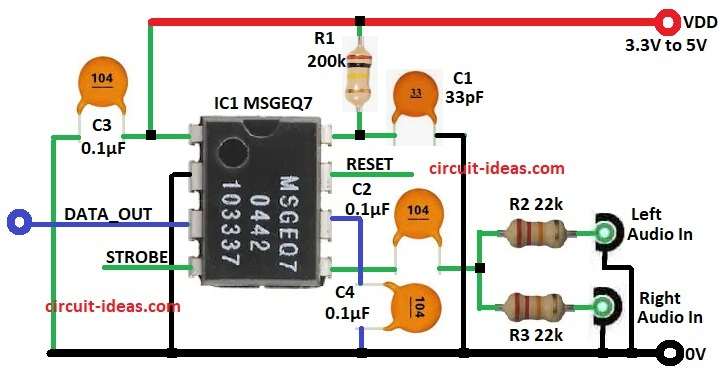Music is not only for ears, it can be seen also.
With MSGEQ7 chip we can make music dance in lights
MSGEQ7 is a chip made for audio spectrum analysis.
It divides audio into 7 frequency bands.
Each band gives an output voltage.
This voltage can be read by microcontroller.
Like Arduino, ESP32, STM32 etc.
Circuit is good for making music visualizer, LED lights dancing and audio meters.
Simple vertical bar diagram (7 bands, 8 LEDs per band).
Each column = one frequency band (7 columns).
Top = high level, bottom = low level.
Band7 █ █ █ █ █ █ █ █
Band6 █ █ █ █ █ █ █ ░
Band5 █ █ █ █ █ ░ ░ ░
Band4 █ █ █ █ ░ ░ ░ ░
Band3 █ █ █ ░ ░ ░ ░ ░
Band2 █ █ ░ ░ ░ ░ ░ ░
Band1 █ ░ ░ ░ ░ ░ ░ ░
1 2 3 4 5 6 7 (columns = bands)
Legend: █ = LED on, ░ = LED off.
We can change 8 to any number of LEDs per column.
Simple horizontal bar diagram (7 rows, variable length).
Each row = one band and Length = level.
Band7: ████████
Band6: ██████
Band5: ████
Band4: ███
Band3: ██
Band2: █
Band1: █Compact 7-bar single-row (good for LED strip):
One row, 7 groups and each group has 3 LEDs.
[ B1: ▓▓ ] [ B2: ▓▓▓ ] [ B3: ▓ ] [ B4: ▓▓▓▓ ] [ B5: ▓▓ ] [ B6: ▓▓▓ ] [ B7: ▓▓▓▓ ]Circuit Working:

Parts List:
| Component | Value | Quantity |
|---|---|---|
| Resistors | ||
| 200k 1/4 watt | 1 | |
| 22k 1/4 watt | 2 | |
| Capacitors | ||
| 33pF | 1 | |
| 0.1µF | 3 | |
| Semiconductors | ||
| IC MSGEQ7 | 1 |
The above circuit diagram is single MSGEQ7 with mono input.
Audio input passes through resistor and capacitor.
Chip separates into 7 bands.
Output pin gives DC voltage for each band.
STROBE pin move to next band.
DATA_OUT pin send band level.
Left and right channel are mixed with two 22k resistors.
Then same capacitor coupling are into input pin.
So both channel combined to mono before chip.
Chip then works the same way.
Formulas:
R1 and C1 make oscillator.
fosc = 1 / (2.2 * R1 * C1)
here,
- fosc is for oscillator frequency
- R1 is 200k
- C1is 33pF
R1 = 200k = 200,000Ω
C1 = 33pF = 33 × 10⁻¹² F
Multiply R1 and C1:
200,000 × 33 × 10⁻¹² = 6.6 × 10⁻⁶
Multiply by 2.2:
2.2 × 6.6 × 10⁻⁶ = 1.452 × 10⁻⁵
Take reciprocal to get fosc:
fosc = 1 / 1.452 × 10⁻⁵ = 68,831 Hz = 68.9 kHz
This is the required clock frequency for the filter banks.
Input filter:
RC high pass is made by R2 and C2.
fcutoff = 1 / (2 * π * R2 * C2)
here,
- fcutoff is cutoff frequency of a filter which is usually in Hz
- R2 is 22k
- C2 is 0.1uF
Multiply R2 and C2:
22,000 × 0.1 × 10⁻⁶ = 2.2 × 10⁻³
Multiply by 2π (6.2832):
6.2832 × 2.2 × 10⁻³ = 0.013823
Take reciprocal to get fcutoff:
fcutoff = 1 / 0.013823 = 72.3 Hz
This removes DC and passes only the audio frequencies.
How to Build:
To build a Audio Spectrum Analyzer Circuit using IC MSGEQ7 follow the below steps:
- Gather all the parts as shown in circuit diagram
- Pin1 VDD of IC MSGEQ7connect to 3.3V or 5V
- Pin2 GND connect 0V
- Pin3 DATA_OUT goes to microcontroller ADC
- Pin4 STROBE control by microcontroller
- Pin5 AUDIO_IN go to audio IN left and Audio IN right through resistor R2 and R3 and capacitor C2
- Pin6 GND go with capacitor C4 to filter noise
- Pin7 RESET control by microcontroller
- Pin8 Rbias connect resistor R1 to VDD and capacitor C1 to ground.
Conclusion:
MSGEQ7 is easy chip for spectrum analyzer.
Only few parts are needed.
Works with mono or stereo input.
Output is easy to read by Arduino or any microcontroller.
Circuit is good for DIY music visualizer projects.
Leave a Reply